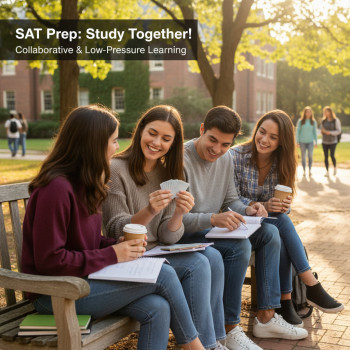Why This Moment Matters: The Global Turn in SAT Data
Walk into any college counseling office today and you’ll hear the same buzz: the SAT is no longer just a U.S.-centric metric. Increasing numbers of international students are taking the Digital SAT, and that shift is quietly reshaping the statistics colleges rely on, the way admissions officers read applications, and the strategies smart students use to prepare. Whether you’re an international applicant, a domestic student watching the landscape change, or a tutor helping others, understanding this trend is more than academic curiosity — it’s practical, strategic, and empowering.
What’s actually changing?
At a glance, the change looks like three things happening at once: more international test-takers, a wider spread of scores and educational backgrounds, and a growing reliance on digital reporting and analytics. Those dynamics affect averages, percentile ranks, and even the stories that high SAT scores tell about a student.
Why more international students are taking the SAT
The reasons are straightforward but powerful. Global access to U.S. higher education has expanded, universities have increased their international outreach, and the Digital SAT’s format and logistics make it easier for test centers abroad to administer the exam and report scores securely. Add to that the rising popularity of U.S. degrees in many countries and the SAT’s continued role in scholarship and admission processes — and you get a steady climb in international participation.
Practical drivers behind the trend
- Global demand for U.S. universities and scholarships.
- Better local access to testing centers and test sessions abroad.
- Digital delivery that simplifies administration, scoring, and score reporting.
- Increased awareness among international families about U.S. admission pathways.
How international participation shifts SAT statistics
Numbers are not just numbers: they tell stories about who’s testing and why. When a larger and more diverse international cohort enters the dataset, a few statistical impacts follow:
1. Changes in mean and median scores
With more test-takers from a variety of educational backgrounds, the overall mean score for all SAT takers may shift. Some regions produce clusters of very high scores due to selective preparation cultures, while other regions may bring more moderate averages. The result is a richer, more complex distribution of scores.
2. Percentile reinterpretation
Percentiles are relative. If many high-scoring international students enter the pool, a given numerical score might correspond to a slightly lower percentile than it used to — which matters for students and counselors who use percentiles to judge competitiveness.
3. Greater variance and wider score distribution
Diversity in schooling and preparation leads to more variance. A wider spread makes some selective colleges look more closely at context — curriculum, country, language of instruction — when interpreting scores.
What colleges see — and what they do with that information
Admissions teams are data-aware but story-driven. Raw scores matter, but so does context. As international participation increases, admissions officers are paying more attention to the background behind the numbers: schooling system, language proficiency, opportunities available, and the rigor of coursework.
Contextualization rather than mechanization
Rather than applying a one-size-fits-all threshold, many colleges consider scores in light of an applicant’s educational ecosystem. A 1350 in one schooling system may have a different meaning than 1350 elsewhere when you account for curriculum, grade inflation, and access to standardized-test coaching.
What that means for applicants
- Don’t rely solely on a single test score as your identity — explain your context in essays and recommendations.
- Highlight academic rigor, accomplishments, and learning environment in your application.
- Use optional application materials (like subject tests, portfolios, or school profiles) where permitted to clarify your background.
Practical implications for international and domestic students
Whether you’re sitting the Digital SAT from abroad or navigating a more crowded score landscape at home, there are concrete implications for your strategy.
For international students
- Start early: language fluency and familiarity with the test format compound over time.
- Use official digital practice tools to mimic test conditions — practicing on a device matters when the live test is digital.
- Document your academic context in your application so readers understand the quality of your schooling.
For domestic students
Competition doesn’t necessarily mean defeat. Domestic students should view the trend as an invitation to strengthen the non-score parts of their application: extracurriculars, essays, recommendations, and demonstrated interest. And, of course, keep improving test skills — the Digital SAT rewards strategy as much as content mastery.
How to prepare better in a shifting landscape
Good preparation now blends content knowledge, test strategy, and smart practice — particularly on a digital platform. Here’s a practical, day-by-day approach you can adapt.
Weekly preparation template
- Monday — targeted content review (grammar rules, algebra concepts, problem solving shortcuts).
- Tuesday — practice section under timed conditions (reading or math).
- Wednesday — review mistakes and build micro-lessons for each error type.
- Thursday — language skills and vocab-in-context exercises.
- Friday — full-length practice in digital format every two weeks; light review on off-weeks.
- Weekend — reflection, essay practice, and test-day logistics (sleep, device prep, travel plans).
Real-world example: how a score distribution can change interpretation
Imagine two students with the same SAT score from different backgrounds. Without knowing more, an admissions officer sees a number; with context, they see a story.
| Student | Score | Schooling Context | Suggested Admissions Interpretation |
|---|---|---|---|
| Aisha (International) | 1420 | Public school, English second language, limited test prep resources | High potential; score reflects strong aptitude despite fewer resources. Emphasize perseverance and course rigor. |
| Ben (Domestic) | 1420 | Private prep program, advanced coursework available, several practice tests | Solid achievement; combine score with coursework rigor and leadership for fuller picture. |
How to use this example
If you’re Aisha or Ben, your next move is to tailor how you present yourself. Scores open doors, but context directs how strongly an admissions officer pulls. Use essays, recommendations, and any allowed supplements to fill in the story behind your numbers.
Study strategies that work on the Digital SAT
The Digital SAT isn’t just old content on new screens — the pacing, navigation, and on-screen tools change how you should practice.
Top tactics
- Practice with the same type of device you’ll use on test day so you’re comfortable scanning passages and entering answers on-screen.
- Master time management by practicing with the exam’s digital timing structure — learn to chunk reading passages, and practice quick math approaches that reduce calculation time.
- Use targeted drills for the most commonly missed question types and then simulate full-length sections to build stamina.
Why personalization matters
Every student’s weak spots differ. Some need help with command of evidence, others with algebraic fluency. That’s where tailored coaching makes a difference: focused sessions that zero in on your patterns of mistakes accelerate progress faster than generic study plans.
Where personalized tutoring fits — a natural mention of Sparkl
If you’re looking for that kind of personalization, programs like Sparkl’s personalized tutoring can be a strong fit. With one-on-one guidance, tailored study plans, expert tutors who understand the Digital SAT format, and AI-driven insights that track your improvement, students often shave months off their preparation time. The key is alignment: choose tutoring that adapts to your progress, gives clear micro-goals, and builds confidence for test day.
What to expect from effective personalized tutoring
- Diagnostic assessment to identify high-impact weak areas.
- A study plan that matches your schedule, strengths, and college goals.
- Regular progress checks and adjustments driven by performance data.
- Practice in the exact digital format of the exam.
Interpreting admission signals in a globalized applicant pool
As admissions offices see more international applicants, they’re refining what they read into scores. Some signals to watch for in your own application:
Academic rigor vs. resource-driven prep
Admissions teams try to distinguish deep academic achievement from outcomes driven primarily by test prep access. Showing sustained performance in rigorous coursework, project work, and subject mastery can help demonstrate authentic academic strength.
Language and adaptation indicators
For non-native English speakers, strong scores paired with advanced coursework or evidence of sustained reading and writing can signal readiness for an English-language academic environment.
Checklist: Concrete steps to stand out in this changing environment
- Use official digital practice tools and simulate test-day conditions.
- Take a diagnostic test early and make a targeted plan from the results.
- Document your academic context clearly in your application materials.
- Prioritize quality over quantity in extracurriculars — show depth.
- Consider personalized tutoring if you need focused, efficient improvement; look for services offering one-on-one guidance, tailored plans, and data-driven feedback.
- Polish essays to tell the story behind the numbers — your journey, not just your score.
Frequently asked questions students actually ask
Will more international students make the SAT more competitive?
Not exactly. It changes the statistical environment, but admissions teams use context. A single score doesn’t define you; how you present your background matters just as much.
Should I worry about percentiles dropping?
No need to panic. Percentiles are a moving target; focus on improving your raw skills and on making your application holistic. Percentiles are one signal among many.
How can I show colleges my academic potential beyond a single score?
Lean on course rigor, letters of recommendation, academic projects, performance in school-based assessments, and thoughtful essays that explain your context and intellectual curiosity.
Looking ahead: what this trend could mean for the future of admissions
The internationalization of SAT takers nudges admissions toward more nuanced evaluations and greater emphasis on holistic review. As test data becomes more globally diverse, institutions will increasingly rely on a mix of scores, qualitative materials, and contextual indicators to make fair decisions.
For students planning ahead
- Invest in versatile skills — critical reading, clear writing, and quantitative reasoning — because they travel across systems and tests.
- Build a clear narrative in your application that explains your schooling, opportunities, and ambitions.
- Use practice data to iterate quickly: treat every practice test as actionable feedback, not just a number.
Final thought: Turn statistical change into personal advantage
Numbers change. What doesn’t change is the advantage of preparation that’s thoughtful, contextual, and personalized. As the SAT becomes more global in scope, your opportunity is to use that diversity to tell a stronger story about who you are as a learner and a potential college student. Lean into targeted practice, present your context clearly, and consider focused tutoring if you want an efficient, guided path to improvement. With clarity and strategy, the changing statistics are not a threat — they’re a new landscape in which prepared, thoughtful students stand out.
Want a next step?
Run a diagnostic, map out a study plan that fits your life, and practice in the exact digital environment of the test. If you want one-on-one help that adapts to your progress, look for personalized tutoring with expert tutors, tailored study plans, and data-driven feedback — the kind of thoughtful guidance that helps students make the most of their effort and reach their goals.















No Comments
Leave a comment Cancel